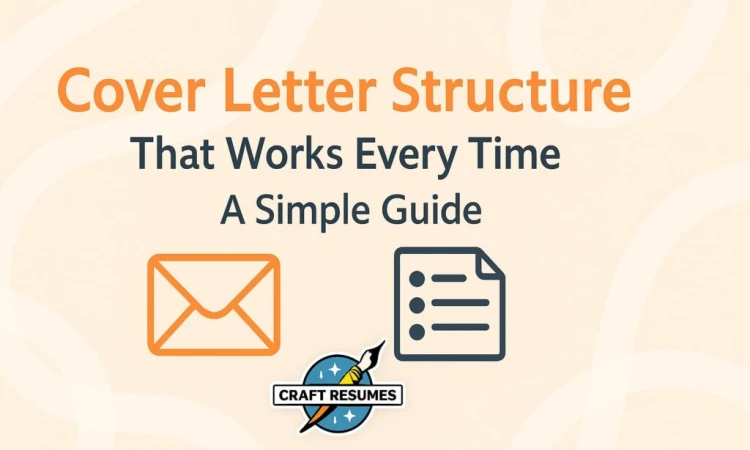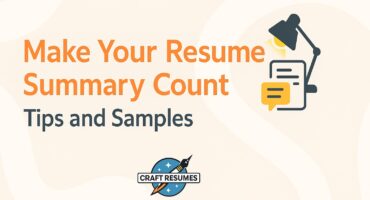
Cover Letter Structure That Works Every Time: A Simple Guide
Jul 13 2025
Many people aren’t sure if cover letters still matter. Some jobs don’t require them, and others leave it optional. However, when a company reads your letter, it can decide if you move forward. But most people don’t know how to write one. They don’t know what to say, how to start, or how to avoid repeating their resume. Some overuse templates that don’t say much. This article shows what a good cover letter includes, including some cover letter samples and templates, what to avoid, and how to write one that is helpful and clear.
How a Good Cover Letter Gets Noticed
A strong cover letter does more than just repeat your resume—it helps demonstrate your unique qualifications. It links your experience to the job and shows why you want it. Clear, focused writing proves you didn’t send the same letter to every job. Here’s what makes a cover letter stand out:
- Clear connection to the job description
- One or two concrete examples that show results
- Awareness of the company’s goals or values
- Direct, confident language without fluff
- A personal tone that still sounds professional
Hiring managers don’t expect a perfect letter, but look for clarity and honesty, addressing any concerns related to your qualifications. This is especially important for federal jobs, where resumes and cover letters must follow specific rules and formats. Many applicants find this challenging on their own. Turning to a professional federal resume writing service and additional resources can make a real difference. These experts help you present your experience clearly while meeting all the required standards, increasing your chances of being a strong candidate and moving forward in the hiring process with effective cover letter examples, templates, and resources.
Differences Between a Cover Letter and a Resume
Both a resume and a cover letter are important when applying for a job, but they do different things. Your resume lists the facts, your experience, skills, and education. It shows what you’ve done. A cover letter adds more to the story. It explains why you did those things, what difference you made, and why that matters to the company you want to work for.
| Element | Resume | Cover Letter |
| Purpose | Lists qualifications | Explains relevance and motivation |
| Tone | Factual and concise | Conversational and targeted |
| Focus | What you did and when | Why it matters and how you did it |
| Format | Bulleted sections | Paragraphs with complete sentences |
| Customization | Slight job-specific tweaks | Tailored to each specific role |
Why Real Examples Matter
If you fixed a problem, improved a process, or met a deadline, share that. Keep it simple: explain the situation, what you did, and what changed because of it. These clear examples help hiring managers see how you work, not just what you say. This can be hard if you’ve worked in a technical job, especially engineering. You might know exactly what you’ve done, but explaining it clearly to someone outside your field isn’t always easy. Getting help from people who know how to write for technical roles can help. Working with resume writers for engineer positions makes it easier to turn your daily tasks into clear points that show your impact without overcomplicating things. It’s a practical way to explore how to improve your cover letter and express inspiration and interest in the job.
A Cover Letter Structure That Just Works
A simple structure keeps you focused and helps you get your message across quickly. Most good cover letters have three parts: a short introduction, the main part, and a closing. Start by saying what job you want, where you found it, and why you are eager for this opportunity. Keep it short—just a few sentences. In the main part, explain why you’re a good fit. Talk about your experience and how it matches what the employer wants. Think about:
- What you did that’s relevant
- How did it help your previous team or company
- The skills you used that match the job requirements
Finish with a clear closing paragraph that reinforces your interest. Show your interest in discussing the role further, offer to provide additional information if needed, and thank the reader for their time. This simple structure keeps your cover letter clear and easy to follow, helping hiring managers understand your value.
Starter Hooks That Grab Attention
The first sentence of your cover letter matters. It either makes the reader want to continue or puts them off immediately. A clear and relevant opening paragraph helps the hiring manager keep reading. Generic or formal openings often fail to make an impact. Here is a comparison:
| Effective Starters | Less Effective Starters |
| “I’m applying for the Marketing Manager role after increasing social media by 40%.” | “I am writing to say about my interest in the position.” |
| “Your company’s focus on innovation led me to apply for the Software Engineer role.” | “Please accept my application for the job opening.” |
| “With five years managing customer service teams, I want to bring my skills to your company.” | “I would like to apply for the role advertised.” |
Show Your Value with Clear Examples
A good cover letter isn’t just a list of skills — it shows what you’ve done and why it matters. Sharing short, clear examples helps the reader see why you’re excited and a good fit for the job. Here are some sample cover letters along with simple examples for different situations to give you an idea.
- Entry-level candidate: “I completed an internship managing social media posts and helped boost engagement by 15%. That experience gave me hands-on skills I’m ready to bring to your marketing team.”
- Career changer: “After working five years in customer support, I took a coding bootcamp and built several web apps. My mix of customer service and programming skills prepares me for this junior developer role.”
- Experienced professional: “In my eight years managing a sales team, we regularly beat targets by 20%. I set up training programs that helped improve team results and increase revenue.”
Thereafter, when you are invited for an interview, preparing well is essential. Interview coaching services can guide you through common questions, offering you the knowledge to help you practice your answers. With this support, you’ll feel more confident and ready to show why you’re the right choice.
Tone That Feels Like You
Your cover letter should sound like you, but also fit what the job and industry expect. Different jobs have different styles. For example, creative roles may be okay with a more casual tone, while legal or finance jobs usually need a formal one. The key is to be clear and honest without going too far, to show your enthusiasm and that you’ve looked into the company. If you’re not sure how to get the tone right or have trouble explaining your strengths, services like CraftResumes can help. They work with many industries and can guide you to write a letter that feels natural but stays professional. They also help you avoid common mistakes, such as not including a proper signature, that might hurt your chances.
Common Mistakes That Weaken Your Cover Letter
Many cover letters fail because of avoidable errors. Knowing what to watch for can help you write a letter that gets read. These common mistakes don’t just make your letter less effective—they can cost you an interview. Here are some common cover letter examples of problems and how to fix them:
- Repeating your resume: Your cover letter should explain how your background matches the job needs and what you can offer.
- Using too many buzzwords: Phrases like “team player” or “detail-oriented” get used too much and don’t say much anymore.
- Not customizing: Sending the same cover letter to every employer doesn’t work. Adjust your letter to fit the job and highlight the skills they’re asking for.
How to Tailor Your Cover Letter for Each Job
Match your letter to the specific role and company shows your desire to align with their needs and that you’ve researched and understood what they want. This is especially true for roles like product manager, where it’s essential to highlight the right skills that align with your career path, and free resources can help you identify these skills. Many people get help from a product manager resume writing service that knows how to explain experience clearly. That kind of support can strengthen your application and improve your chances. Here are the key details to customize the letter for each job:
| What to Customize | How to Adjust |
| Job Title | Use the exact title from the posting |
| Company Name | Mention the company specifically |
| Skills and Experience | Highlight those that match the job listing |
| Key Achievements | Pick examples relevant to the role |
The writers at CraftResumes know how to adjust a cover letter for different jobs and fields. They ensure it sounds like you and matches what each employer seeks. Their experience helps make an introductory cover letter more personal and relevant, without losing your style.
Simple Cover Letter Template to Start
Many find it tricky to start a cover letter. Here’s an easy template to help you begin. Just add your details and change it for each job you apply to:
Dear [Hiring Manager’s Name],I’m applying for the [Position] at [Company]. This job caught my attention because [brief reason connected to the job or company].
At [Previous Company], I [describe a relevant responsibility or achievement]. This gave me experience in [list key skills or areas].
My background in [your field] will help me contribute to [Company] by [explaining how you can add value].
Thank you for considering my application. I look forward to discussing how I can support your team.
Sincerely,
[Your Name]
Checklist to Improve Your Cover Letter
Before you send your cover letter, take a minute to check it quickly. Small things can change how it comes across, especially when you print your final version. Use this simple list to track your letter and make sure it is clear and hits the main points before creating your final file.
- Use the HR name if you know it
- Share examples that show what you did and how it fits the job
- Write in active voice to keep it straightforward
- Look for spelling and grammar mistakes
- Keep it short—one page is best—so it’s easy to read
- Don’t leave out important details just to make it shorter
Going through this list helps you catch mistakes before anyone else sees them. A clear cover letter makes it easier for hiring managers to understand why you’re a good fit and helps you explore opportunities that lead to an interview.

